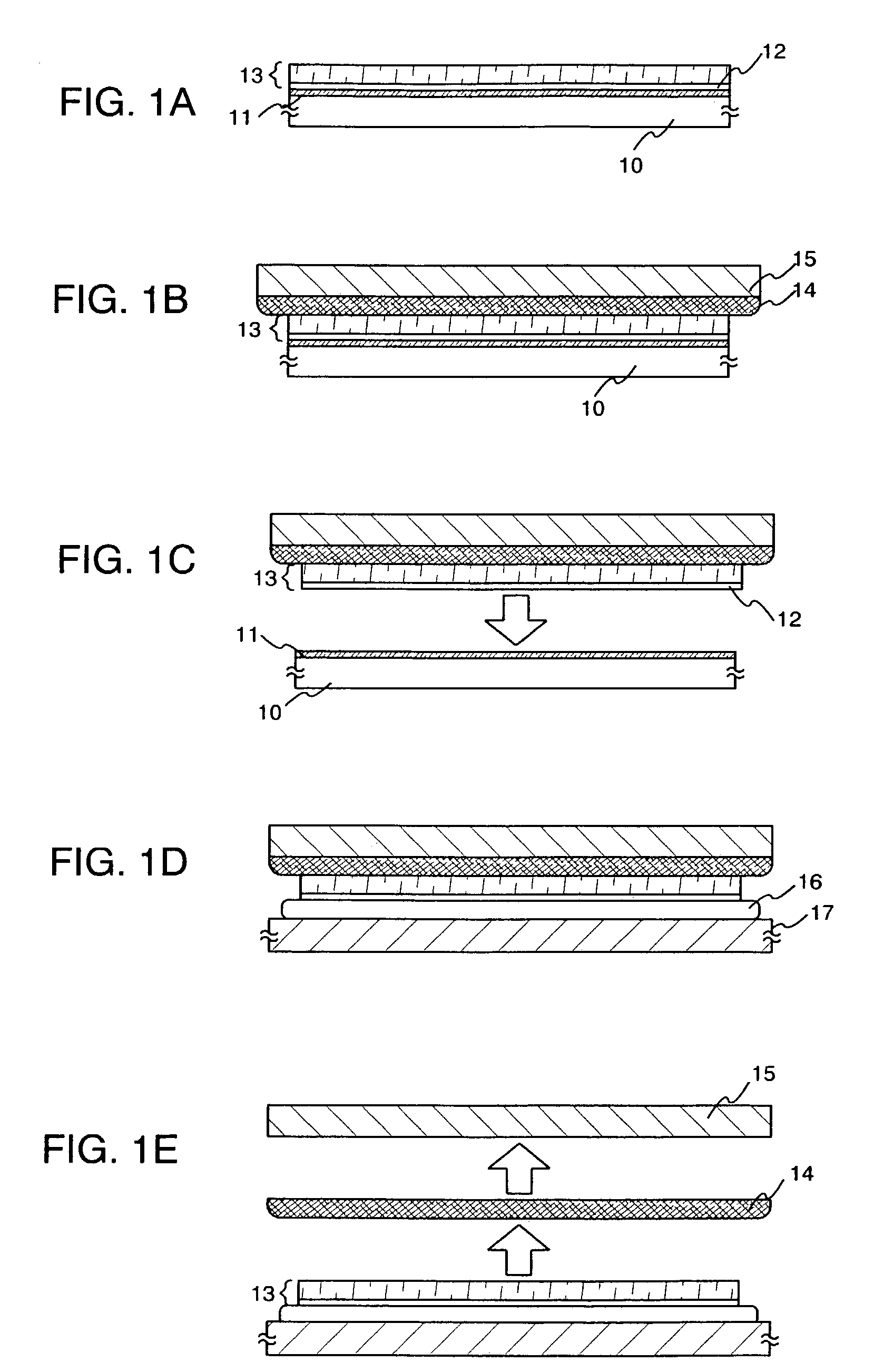Method of transferring a laminate and method of manufacturing a semiconductor device
a technology of semiconductor devices and laminates, applied in the field of methods of transferring laminates and manufacturing methods, can solve the problems of difficult to make large-size glass and quartz substrates, heavy weight and easy breakage, and unsuitable thin-film transistor substrates
- Summary
- Abstract
- Description
- Claims
- Application Information
AI Technical Summary
Benefits of technology
Problems solved by technology
Method used
Image
Examples
embodiment modes
[0044]Embodiment modes of the present invention are explained below.
embodiment mode 1
[Embodiment Mode 1]
[0045]Procedures of a typical transferring method using the present invention are explained briefly using FIGS. 1A to 1E.
[0046]First, a description will be made with reference to FIG. 1A. Reference numeral 10 denotes a substrate, reference numeral 11 denotes a peeling layer, reference numeral 12 denotes an oxide layer, reference numeral 13 denotes an object to be peeled, and includes the oxide layer 12.
[0047]Glass substrates, quartz substrates, ceramic substrates, and the like can be used as the substrate 10. Further, silicon substrates, metallic substrates, and stainless steel substrates may also be used.
[0048]A peeling layer 11, which is a nitride layer or a metallic layer, is formed on the substrate 10. A typical example of the metallic layer includes a single layer made of an element selected from the group consisting of titanium (Ti), aluminum (Al), tantalum (Ta), tungsten (W), molybdenum (Mo), copper (Cu), chromium (Cr), neodymium (Ne), iron (Fe), nickel (Ni...
embodiment mode 2
[Embodiment Mode 2]
[0060]The structure of a peelable adhesive medium (two-sided tape is employed as a typical example) used in a transferring process of the present invention is explained here.
[0061]FIG. 11A and FIG. 11B are explained. The two-sided tape used in the present invention is one in which a first substrate 502 having a first adhesive 501, and a second substrate 504 having a second adhesive 503, are joined together by a cured adhesive 505. Heat-peeling adhesives and / or ultraviolet-peeling adhesives can be used in the first adhesive and in the second adhesive. Further, adhesives that are peelable by the irradiation of light (visible light, infrared light, and the like) (light peeling adhesives), and adhesives that are peelable by a chemical reaction (reaction peeling adhesives) can also be used as substitutes for the ultraviolet-peeling adhesives and the heat-peeling adhesives.
[0062]A heat-peeling adhesive and an ultraviolet-peeling adhesive are used as typical examples of ...
PUM
| Property | Measurement | Unit |
|---|---|---|
| period of time | aaaaa | aaaaa |
| temperature | aaaaa | aaaaa |
| temperature | aaaaa | aaaaa |
Abstract
Description
Claims
Application Information
 Login to View More
Login to View More - R&D
- Intellectual Property
- Life Sciences
- Materials
- Tech Scout
- Unparalleled Data Quality
- Higher Quality Content
- 60% Fewer Hallucinations
Browse by: Latest US Patents, China's latest patents, Technical Efficacy Thesaurus, Application Domain, Technology Topic, Popular Technical Reports.
© 2025 PatSnap. All rights reserved.Legal|Privacy policy|Modern Slavery Act Transparency Statement|Sitemap|About US| Contact US: help@patsnap.com



